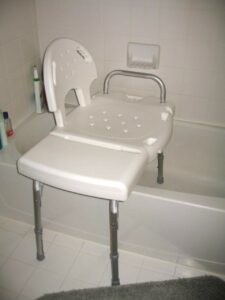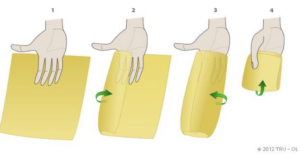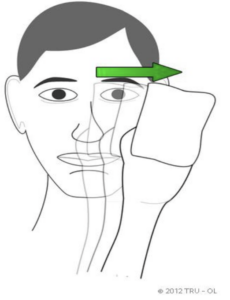4.3 Personal Hygiene Care
Personal hygiene care is provided in both supportive care facilities and in a client’s home. Personal hygiene care includes the basic personal hygiene that is done either by the client or by the HCA every morning and evening.
Considerations for A.M. Care
Watch this video, Chapter 1- Considerations for A.M. Care – BCcampus, written and produced by Chantal Lortie and Natasha Fontaine (2022), from Selkirk College and COTR, and licensed under a CC BY-NC 4.0 licence.
The skills outlined below describe personal hygiene in a supportive care facility. It can, of course, be adapted to provide care in the home. When doing personal hygiene care (often referred to as morning or A.M. care, and bedtime or P.M. care) you usually do not give the client a full bath. The areas that are washed, rinsed, and dried are:
- Face including eyes, neck, and behind the ears
- Axilla (underarm area) and under breasts
- Hands
- Back from neck to lower back
- Perineal (genital) area
Before Beginning A.M. Care
Next, watch this video, Chapter 2- Before Beginning A.M. Care – BCcampus, also written and produced by Chantal Lortie and Natasha Fontaine (2022), from Selkirk College and COTR, and licensed under a CC BY-NC 4.0 licence.
Bathing
Assisting a client with regular bathing is important for their health and for promoting self-esteem and healing. Clients who are recovering from an injury or illness, who have a chronic condition, who are permanently disabled, who are dying, or who are frail, may require assistance for performing this essential task (Sorrentino, et al., 2019; Taylor, et al., 2001). This is an important part of the job of an HCA. The care plan will direct the HCA as to the frequency and type of bath that should be performed. At minimum, a client should have their face, underarms, under breasts or folds, hands, and genital areas cleansed daily in the morning and evening.
Providing personal care gives HCAs an opportunity to observe and communicate with clients (Sorrentino, et al., 2019). Covering the areas to be washed with the bath blanket or towel maintains warmth and dignity. Providing personal hygiene care gives the HCA the opportunity to observe the client’s skin condition by uncovering and observing each area as you wash. The HCA should observe the client’s skin for changes in colour, temperature, swelling, new bruises, open areas, red areas, or sores. These should be documented and the supervisor informed.
Health Care Assistants should always encourage the client to perform any personal hygiene task they are able to, and help as needed. Some clients are able to bathe or shower independently, or with minimal assistance. Some clients will require total care, meaning the HCA will have to provide their personal hygiene care completely (McLain, et al., 2018). If a client is immobile, weak, or frail, bed baths should be provided instead of risking a fall in a bathtub. Never allow a weak or frail client to stand in a shower alone. In these types of situations, a tub or bed bath may be more appropriate. The HCA can also shampoo the client’s hair in bed by using a shampoo tray or a no-rinse shampoo cap.
Clients have a right to refuse any treatment, including bathing. The HCA should educate the client about the importance of bathing and try to find out why the client does not want a bath. Sometimes, they may not want a bath at a particular time, but would be willing to have one at a later time. Document the reason for refusal and inform the supervisor (Sorrentino, et al., 2019; Taylor, et al., 2001).
When providing or assisting with a bath, the water temperature should be checked. The temperature should be no greater than 40°C. Allow clients to test the water temperature to determine whether it is comfortable for them. It is important, when providing or assisting with a bath, that the client is provided privacy (Sorrentino, et al., 2019; McLain, et al., 2018). This includes closing doors, drawing curtains, and limiting access to the area for others while the client is bathing. Towels, gowns, or bath blankets can be used to cover the client’s body, exposing only the body part being washed during bed baths. Sometimes allowing the client to get into the bath with their gown or shirt on will not only make the client feel comfortable, but will also make the bathing experience go more smoothly.
Providing a back rub after a bath, before bed, or anytime a client needs to relax is an important skill for the Health Care Assistant, but is often overlooked. This is an excellent way to teach a client how to relax, observe their skin, and promote good circulation. Giving a proper back rub is discussed later in this unit.
Instructions for providing a tub or shower bath, assisting with a transfer into and out of a tub, providing a bed bath, and providing a shampoo in bed are also discussed later in the unit.
Tub or Shower Bath
| STEP | ACTION | REASON |
|---|---|---|
| 1. | Read the client’s care plan. | |
| 2. | Wash and dry hands according to proper handwashing guidelines. | |
| 3. | Assemble equipment needed:
|
Good organization is time efficient. |
| 4. | Ensure the bathroom is warm and comfortable. Take care that it is not too cold or too hot. | Client comfort. |
| 5. | Remove any fall risk hazards, such as loose rugs, from the floor. | Safety. |
| 6. | Place any safety devices in the tub or shower as needed (e.g., shower chair, rubber mats). |
 |
| 7. | Ensure safety items such as handrails and grab bars are in good working order. Immediately inform a supervisor if they are not. | |
| 8. | Turn on the water and test the water temperature using a bath thermometer. Water temperature should be no higher than 40°C. If providing a tub bath, fill the bath and test the temperature before putting the client in the tub. | To prevent scalding injury |
| 9. | Allow the client to test the water temperature for their comfort. Adjust as needed. | |
| 10. | Assist the client to the bathroom. If the client is ambulatory, assist as needed to undress just before transferring them into the tub or shower. This prevents them from chilling. | |
| 11. | If the client is independent, give them privacy to bathe, if they prefer. If leaving a client unattended, check on them every 5 minutes or more frequently as needed. Ensure the client knows how to use safety items, such as shower chairs and grab bars. | Tub baths, or very warm showers, can lead to a person feeling faint, nauseous, or tired. Baths should not last longer than 20 minutes and should be discontinued at the first sign of client discomfort, weakness, or complaints of feeling faint. |
| 12. | If the client is standing to shower, stay in the bathroom and monitor the client’s need for assistance. If they are weak, always stay with them in the bathroom, providing privacy as possible. | |
| 13. | Never let a weak person stand to bathe or leave them alone in the bath. You can stay in the bathroom and draw the shower curtain to provide privacy. Communicate with the client frequently to let them know you are there to help. | |
| 14. | Water should be turned off, and the tub drained, before assisting the client to transfer out of the tub. |
Partial Bed Bath
Health Care Assistants should always encourage the client to perform any personal hygiene task they are able to, and help as needed. Some clients will require personal hygiene care in bed because they are unable to move to the bath or shower. Providing a bed bath allows a client to receive personal hygiene care with minimal movement on their part. There are two types of bed baths: full and partial. A full or complete bed bath requires the care provider to clean the client’s entire body — head-to-toe. Whereas a partial bed bath is washing the important areas, such as the face, neck, axilla, hands, and peri-area. Perineal care (peri-care) involves cleaning the urethral meatus, vagina or penis, perineum (the area between the vagina or penis and the anus), and anal areas. Peri-care is critical as this area is prone to infection and must be cleaned daily, especially if the client is incontinent.
| STEP | ACTION | REASON |
|---|---|---|
| 1. | Read the client’s care plan. | |
| 2. | Call the client by their name. Introduce yourself and explain what you are going to do. | Minimizes embarrassment to the client by using clear and respectful communication. |
| 3. | Wash your hands. Set up the environment and provide privacy. Make sure windows are closed and the room is warm enough. Assemble all supplies. For washing, you should have the following supplies ready:
|
Good organization saves time. |
| 4. | Raise the bed to working height. | Allows the use of correct body mechanics and protects you from back injury. |
| 5. | Lower the bed rails nearest to you. Place the towel across the client’s chest. | Safety and client’s comfort. |
| 6. | Make a bath mitt with the washcloth by folding it over your hand. Wet the bath mitt and squeeze out excess water. Keep access to the water basin close to prevent dripping water over the client. | Provides a thick, soft surface to wash with.
Bath mitt  |
| 7. | Eyes
Note: Many clients will have mucous crusting caked along the eyelashes. To remove this crusting, fold a warm wet washcloth and place it over the eyes for a few minutes. Remove the cloth and gently wash away the crusting using the procedure for washing the eyes. |
 |
| 8. | Face, Head, Neck, and Ears
|
This follows the principles of asepsis (working from clean to dirty) to prevent the transfer of microorganisms.
Many clients have dry skin and do not need soap on their faces. Soap will dry the skin more. |
| 9. | Axilla and Breasts
|
Privacy, self-esteem.
Always encourage independence and range of motion for joints. |
| 10. | Hands
|
Putting the client’s hand in a basin of water is a more thorough way of washing the hand than just wiping it with a washcloth. It is also comforting and relaxing. |
| 11. | Assist client to put on clean gown. Apply deodorant as desired by the client. | Self-esteem and comfort, as well as client comfort and privacy. |
| 12. | Perineal Area
See Perineal Care (4.4) for detailed information on perineal care. |
|
| 13. |
|
For safety and medical asepsis. |
| 14. | Back
|
To prevent water dripping on bed linens to maintain medical asepsis. |
| 15. | Back Massage
|
To promote self-esteem and comfort.
Do not massage or rub hot reddened areas, as these may be the start of a pressure sore. |
| 16. |
|
|
| 17. |
|
To maintain a tidy environment. |
| 18. | Wash hands. | To maintain medical asepsis to prevent cross-contamination. |
| 19. | Report and record observations to supervisor. |
Video: The “Personal Care – Health Care” video playlist demonstrates the techniques for Personal Hygiene Care.
From the Personal Care – Health Care Playlist, watch the Personal Care (Chapters 3–10) videos, from BCcampus. These videos were written and produced by Chantal Lortie and Natasha Fontaine (2022), from Selkirk College and College of the Rockies (COTR), and licensed under a CC BY-NC 4.0 licence.
Care given in the morning to prepare the client for the day. It includes bathing, shaving, dressing, grooming, and oral care.
Care given in the evening or at bedtime. It includes washing face and hands, oral care, and removing and cleaning dentures. If a client is dressed, they change into sleepwear. P.M. care may also include backrub to help a client relax before sleeping. Also called H.S. (hour of sleep) care.
A complete bed bath that involves washing the entire body from head to toe.
A partial bed bath involves washing the face, hands, underarms and genital/perineal area.
Washing or bathing the genitalia and surrounding area. Peri-care is commonly used as a shortened form of perineal care.
The tiny area of sensitive skin between the genitals (vaginal opening or scrotum) and anus, and it’s also the bottom region of the pelvic cavity. Sometimes referred to as the peri-area.
The procedures to reduce the number of microorganisms and prevent their spread. Also known as clean technique.

